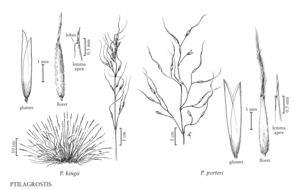Difference between revisions of "Ptilagrostis kingii"
Common names: King's ptilagrostis Sierra ptilagrostis
Endemic
Synonyms: Oryzopsis kingii
Treatment appears in FNA Volume 24. Treatment on page 143.
imported>Volume Importer |
imported>Volume Importer |
||
| Line 47: | Line 47: | ||
|publication year= | |publication year= | ||
|special status=Endemic | |special status=Endemic | ||
| − | |source xml=https://bitbucket.org/aafc-mbb/fna-data-curation/src/ | + | |source xml=https://bitbucket.org/aafc-mbb/fna-data-curation/src/200273ad09963decb8fc72550212de541d86569d/coarse_grained_fna_xml/V24/V24_193.xml |
|subfamily=Poaceae subfam. Pooideae | |subfamily=Poaceae subfam. Pooideae | ||
|tribe=Poaceae tribe Stipeae | |tribe=Poaceae tribe Stipeae | ||
Latest revision as of 16:22, 11 May 2021
Culms 15-38 cm tall, 0.4-0.8 mm thick. Basal ligules 1-2 mm, acute; upper ligules to 2.5 mm; blades filiform, about 0.3 mm in diameter. Panicles 6-10 cm, loosely contracted; branches ascending to appressed. Glumes 3-4.5 mm; florets 2.8-4.2 mm; calluses 0.3-0.7 mm; lemmas with 0.1-0.4 mm lobes; awns 10-14 mm, scabridulous, not hairy, weakly once- or twice-geniculate; anthers 0.5-1.5 mm, penicillate. Caryopses 1.5-2.3 mm. 2n = 11.
Discussion
Ptilagrostis kingii grows along damp streambanks and wet meadows of the Sierra Nevada, at elevations from 2700-3500 m. It differs from most species in the genus in its scabridulous, rather than plumose, awns and short lemma lobes.
Selected References
None.
Lower Taxa
None.
